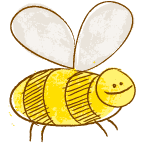INVESTING IN EQUIPMENT & BEES
There are a lot of ways to get your first colony or two. I recommend starting with two nuc (nucleus) hives. These are small colonies that have all the resources they need to start growing. Usually, you purchase five frames that include nectar, pollen, brood, and a queen. Having two colonies means you’ll have the ability to compare, contrast, and share resources if needed. Additionally, you’ll need to have your woodware ready, as nucs often come in cardboard boxes. This means choosing the style of the hive: Langstroth, Top Bar, or others. Choosing one style of hive can help with equipment costs and storage.
EXIT PLAN
Rehoming bees is typically easier than rehoming a dog or cat. If you do decide to dive into beekeeping, knowing your exit plan is wise. Luckily, many beekeepers are happy to take on a hive from someone who needs to rehome a colony.
IF BEING AN ADVOCATE IS MORE YOUR SPEED
Share your bee enthusiasm with friends and neighbors! You don’t have to keep bees to be an advocate. I find myself sharing bee lessons with neighborhood kids in the driveway, adults at backyard gatherings, and anyone willing to listen in the middle of the street.
MORE RESOURCES FROM US
Our Honey Bee Experience Box is full of tools you can use, including creating your own at-home lesson plan. The Thing About Bees by Shabazz Larkin - with our companion reading guide available - is a fabulous book to introduce kids to our honey bee friends. Our downloadable Inside Buzz guide is filled with honey bee education and activities for kids 5-11. Additionally, we have lots of illustrative photos on our website that you can use to show kids what’s happening in a hive.







